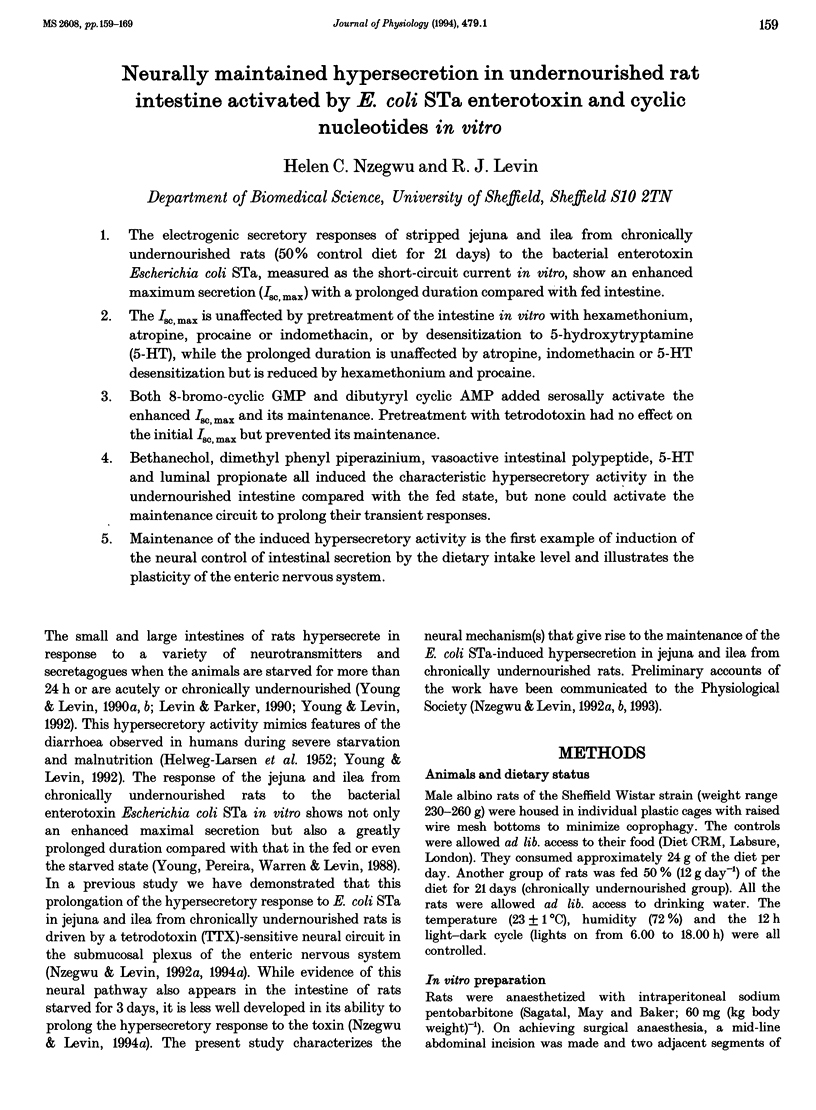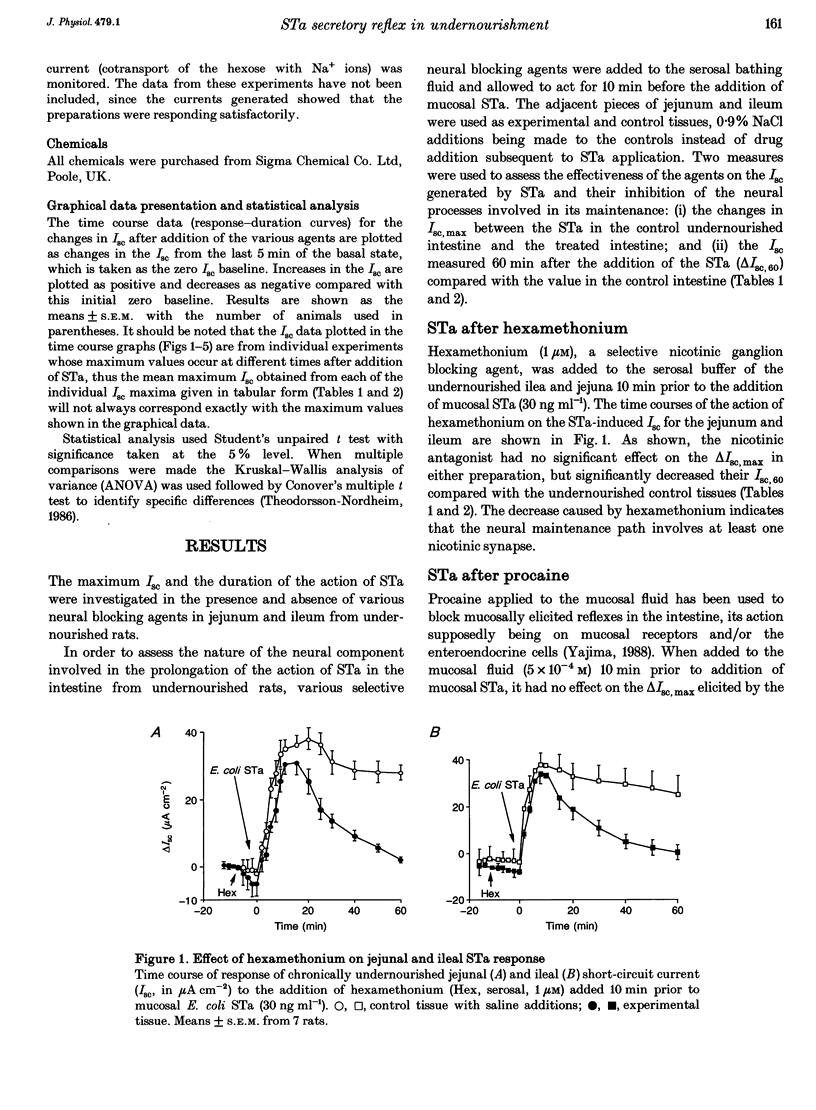Abstract
1. The electrogenic secretory responses of stripped jejuna and ilea from chronically undernourished rats (50% control diet for 21 days) to the bacterial enterotoxin Escherichia coli STa, measured as the short-circuit current in vitro, show an enhanced maximum secretion (ISC, max) with a prolonged duration compared with fed intestine. 2. The ISC, max is unaffected by pretreatment of the intestine in vitro with hexamethonium, atropine, procaine or indomethacin, or by desensitization to 5-hydroxytryptamine (5-HT), while the prolonged duration is unaffected by atropine, indomethacin or 5-HT desensitization but is reduced by hexamethonium and procaine. 3. Both 8-bromo-cyclic GMP and dibutyryl cyclic AMP added serosally activate the enhanced ISC, max and its maintenance. Pretreatment with tetrodotoxin had no effect on the initial ISC, max but prevented its maintenance. 4. Bethanechol, dimethyl phenyl piperazinium, vasoactive intestinal polypeptide, 5-HT and luminal propionate all induced the characteristic hypersecretory activity in the undernourished intestine compared with the fed state, but none could activate the maintenance circuit to prolong their transient responses. 5. Maintenance of the induced hypersecretory activity is the first example of induction of the neural control of intestinal secretion by the dietary intake level and illustrates the plasticity of the enteric nervous system.
Full text
PDF










Selected References
These references are in PubMed. This may not be the complete list of references from this article.
- Beubler E., Badhri P., Schirgi-Degen A. 5-HT receptor antagonists and heat-stable Escherichia coli enterotoxin-induced effects in the rat. Eur J Pharmacol. 1992 Sep 4;219(3):445–450. doi: 10.1016/0014-2999(92)90486-n. [DOI] [PubMed] [Google Scholar]
- Cohen M. B., Nogueira J., Laney D. W., Jr, Conti T. R. The jejunal secretory response to Escherichia coli heat-stable enterotoxin is prolonged in malnourished rats. Pediatr Res. 1992 Mar;31(3):228–233. doi: 10.1203/00006450-199203000-00007. [DOI] [PubMed] [Google Scholar]
- Currie M. G., Fok K. F., Kato J., Moore R. J., Hamra F. K., Duffin K. L., Smith C. E. Guanylin: an endogenous activator of intestinal guanylate cyclase. Proc Natl Acad Sci U S A. 1992 Feb 1;89(3):947–951. doi: 10.1073/pnas.89.3.947. [DOI] [PMC free article] [PubMed] [Google Scholar]
- Eklund S., Cassuto J., Jodal M., Lundgren O. The involvement of the enteric nervous system in the intestinal secretion evoked by cyclic adenosine 3'5'-monophosphate. Acta Physiol Scand. 1984 Feb;120(2):311–316. doi: 10.1111/j.1748-1716.1984.tb00139.x. [DOI] [PubMed] [Google Scholar]
- Eklund S., Jodal M., Lundgren O. The enteric nervous system participates in the secretory response to the heat stable enterotoxins of Escherichia coli in rats and cats. Neuroscience. 1985 Feb;14(2):673–681. doi: 10.1016/0306-4522(85)90318-5. [DOI] [PubMed] [Google Scholar]
- Eklund S., Jodal M., Lundgren O. The net fluid secretion caused by cyclic 3'5'-guanosine monophosphate in the rat jejunum in vivo is mediated by a local nervous reflex. Acta Physiol Scand. 1986 Sep;128(1):57–63. doi: 10.1111/j.1748-1716.1986.tb07949.x. [DOI] [PubMed] [Google Scholar]
- Field M., Graf L. H., Jr, Laird W. J., Smith P. L. Heat-stable enterotoxin of Escherichia coli: in vitro effects on guanylate cyclase activity, cyclic GMP concentration, and ion transport in small intestine. Proc Natl Acad Sci U S A. 1978 Jun;75(6):2800–2804. doi: 10.1073/pnas.75.6.2800. [DOI] [PMC free article] [PubMed] [Google Scholar]
- HELWEG-LARSEN P., HOFFMEYER H., KIELER J., HESS THAYSEN E., HESS THAYSEN J., THYGESEN P., HERTEL WULFF M. Famine disease in German concentration camps; complications and sequels, with special reference to tuberculosis, mental disorders and social consequences. Acta Psychiatr Neurol Scand Suppl. 1952;83:1–460. [PubMed] [Google Scholar]
- Hubel K. A. The effects of electrical field stimulation and tetrodotoxin on ion transport by the isolated rabbit ileum. J Clin Invest. 1978 Nov;62(5):1039–1047. doi: 10.1172/JCI109208. [DOI] [PMC free article] [PubMed] [Google Scholar]
- Levin R. J., Parker A. J. Rectal electrogenic secretion--is it a putative indicator of intestinal secretory status induced by nutritional deprivation in the rat? Exp Physiol. 1990 Jul;75(4):609–611. doi: 10.1113/expphysiol.1990.sp003438. [DOI] [PubMed] [Google Scholar]
- Lundgren O., Svanvik J., Jivegård L. Enteric nervous system. I. Physiology and pathophysiology of the intestinal tract. Dig Dis Sci. 1989 Feb;34(2):264–283. doi: 10.1007/BF01536062. [DOI] [PubMed] [Google Scholar]
- Rolfe V., Levin R. J. Enterotoxin Escherichia coli STa activates a nitric oxide-dependent myenteric plexus secretory reflex in the rat ileum. J Physiol. 1994 Mar 15;475(3):531–537. doi: 10.1113/jphysiol.1994.sp020091. [DOI] [PMC free article] [PubMed] [Google Scholar]
- Sagmanligil V., Levin R. J. Electrogenic ion secretion in proximal, mid and distal colon from fed and starved mice. Comp Biochem Physiol C. 1993 Oct;106(2):449–456. doi: 10.1016/0742-8413(93)90161-d. [DOI] [PubMed] [Google Scholar]
- Schulz S., Chrisman T. D., Garbers D. L. Cloning and expression of guanylin. Its existence in various mammalian tissues. J Biol Chem. 1992 Aug 15;267(23):16019–16021. [PubMed] [Google Scholar]
- Tapper E. J., Lewand D. L. Actions of a nicotinic agonist, DMPP, on intestinal ion transport in vitro. Life Sci. 1981 Jan 12;28(2):155–162. doi: 10.1016/0024-3205(81)90547-6. [DOI] [PubMed] [Google Scholar]
- Theodorsson-Norheim E. Kruskal-Wallis test: BASIC computer program to perform nonparametric one-way analysis of variance and multiple comparisons on ranks of several independent samples. Comput Methods Programs Biomed. 1986 Aug;23(1):57–62. doi: 10.1016/0169-2607(86)90081-7. [DOI] [PubMed] [Google Scholar]
- Wiegand R. C., Kato J., Huang M. D., Fok K. F., Kachur J. F., Currie M. G. Human guanylin: cDNA isolation, structure, and activity. FEBS Lett. 1992 Oct 19;311(2):150–154. doi: 10.1016/0014-5793(92)81387-2. [DOI] [PubMed] [Google Scholar]
- Yajima T. Luminal propionate-induced secretory response in the rat distal colon in vitro. J Physiol. 1988 Sep;403:559–575. doi: 10.1113/jphysiol.1988.sp017264. [DOI] [PMC free article] [PubMed] [Google Scholar]
- Young A., Levin R. J. Diarrhoea of famine and malnutrition--investigations using a rat model. 2--Ileal hypersecretion induced by starvation. Gut. 1990 Feb;31(2):162–169. doi: 10.1136/gut.31.2.162. [DOI] [PMC free article] [PubMed] [Google Scholar]
- Young A., Levin R. J. Diarrhoea of famine and malnutrition: investigations using a rat model. 1. Jejunal hypersecretion induced by starvation. Gut. 1990 Jan;31(1):43–53. doi: 10.1136/gut.31.1.43. [DOI] [PMC free article] [PubMed] [Google Scholar]
- Young A., Levin R. J. Intestinal hypersecretion of the refed starved rat: a model for alimentary diarrhoea. Gut. 1992 Aug;33(8):1050–1056. doi: 10.1136/gut.33.8.1050. [DOI] [PMC free article] [PubMed] [Google Scholar]


